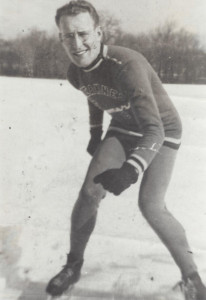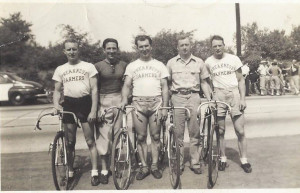If all goes to plan a 55-year-old skier will line up in a few weeks time at the Sochi Winter Olympics – but who are the other “Golden Oldies” who have graced the Winter Games?
These are the oldest competitors to have appeared in each sport currently on the Olympic programme.
Alpine Skiing
Hubertus von Fürstenberg-von Hohenlohe (MEX)
51 years, 26 days at Vancouver 2010
You can say many things about Prince Hubertus of Hohenlohe-Langenburg but you can never, ever, say he has a dull biography. An aristocrat with roots deep in European nobility, he has been a pop singer, professional photographer and businessman at various points in his life. In 1981 he founded the Mexican Skiing Federation in an attempt to participate in international competition. Since then he has competed at 15 World Championships and 5 Winter Olympics and, most recently, placed 56th in the slalom at the 2013 World Championships. Barring illness or injury he will return for one more Olympic appearance in Sochi.
Biathlon
Thanasis Tsakiris (GRE)
45 years, 34 days at Vancouver 2010
After a gap of 12 years Thanasis Tsakiris reappeared on the Olympic stage in 2010 at the age of 45. Originally a cross-country skier, he switched to biathlon in the late 80s and stayed in the sport long enough to compete in the same Olympic team as his daughter. He still competes, albeit at a lower level and has won national titles every year for the last 28 years.
Cross-country skiing
Arturo Kinch (CRC)
49 years, 309 days at Turin 2006
Born to parents who were Protestant missionaries in Costa Rica, Arturo Kinch took up ski racing whilst on a soccer scholarship at a Colorado college. He first competed at the Winter Games as an Alpine skier at Lake Placid in 1980 then returned in 1984 as the first man for over 30 years to compete at both alpine and cross-country at the same Olympics. After a 12-year gap he returned to the Olympic arena in 2006 and finally brought the curtain down on his career in Turin when two months shy of his 50th birthday.
Curling
Carl August Kronlund (SWE)
58 years, 155 days at Chamonix 1924
Oldest competitor at any Olympic Winter Games.
At 58 years of age, Carl August Kronlund was not only the oldest competitor at the inaugural Winter Olympics but also the oldest medal winner. Kronlund, a Stockholm businessman, played in Sweden’s victory over France and received a silver medal for his exploits. For many years it was incorrectly thought that the curling tournament in 1924 was only a demonstration event but, at the start of the 21st century, the IOC confirmed that it was a full medal event.
Figure Skating
Joseph Savage (USA)
52 years, 267 days at Lake Placid 1932
Joseph Savage’s sporting career reads like it should have happened in reverse. A successful attorney with a New York law firm, he was a major figure in the administration on figure skating in America and served a term as the President of the Amateur Skating Union of the USA in 1929-30. Savage was also a relatively successful competitor who was a regular winner of Mid-Atlantic regional titles in the 1920s. He was just short of 50 when he won his 1st medal at the US nationals and 52 when he and partner Gertrude Meredith qualified for the 1932 Olympics. Amazingly his career did not end there and in 1936 he combined with Marjorie Parker Smith to win the inaugural US national title in ice dancing. He was still competing and winning medals at the US Championships aged 63.
Bobsleigh
Hubert Menten (NED)
54 years, 158 days at St. Moritz 1928
A businessman whose family made their fortune in the oil business, Hubert Menten was one of the founders of the Dutch bobsleigh club in Davos, Switzerland which was instrumental in getting the Dutch bob to the 1928 Olympics, and later coached the 1929 Dutch duo that won the European title. An avid art collector and dealer, he was also very much pro-Nazi in his political views and was investigated by the Allied powers for his dealings with Hermann Goering.
Freestyle Skiing
Clyde Getty (ARG)
44 years, 152 days at Turin 2006
Born and raised in North Carolina, Clyde Getty came through the US system before switching to Argentina, the land of the parents, which enabled him to compete at the 2006 Winter Olympics. He continues to compete at World Cup level, although now in his 50s, and has an outside shot at the Sochi Games.
Ice Hockey
Béla Ordódy (HUN)
48 years, 29 days at St.Moritz 1928
Béla Ordódy was a major figure in the early years of Hungarian soccer and played for the first ever Hungarian national team in 1901. He was even awarded a trophy for Hungary’s player of the year in 1902. A generation later Ordódy re-emerged as goaltender for the Hungarian national ice hockey team at the 1928 Winter Olympic Games. At the time there was a fair amount of crossover between the two sports particularly in continental Europe. He only conceded a single goal in his only Olympic appearance but the goal was enough to eliminate Hungary from the tournament.
Luge
Matiás Stinnes (ARG)
53 years, 217 days at Innsbruck 1964
When luge became an Olympic sport Argentina set up a team of six to provide competitors for the 1964 Winter Games. The only survivor of this programme was 53-year-old German born Matiás Stinnes. Stinnes crashed out of the Innsbruck Games but appeared on the entry lists again at the 1968 Games at Grenoble though he withdrew before the competition began.
Nordic Combined
Anders Haugen (USA)
39 years, 115 days at St.Moritz 1928
Already a record holder as the oldest Olympian in his sport’s history, Anders Haugen was 86-years-old when he finally received his Olympic bronze medal. In 1974, at the 50th reunion of the 1924 Norwegian team, Norwegian sports historian Jacob Vaage was going over the results when he noticed an error. Haugen had correctly been given 17.916 points, but 3rd place finisher Thorleif Haug’s scores added up to 17.821, not the 18.000 with which he had been credited. The IOC was notified and at a special ceremony in Oslo, on 12 September 1974, Anders Haugen was given his bronze medal by Haug’s daughter – more than 50 years after the competition.
Short Track Speed Skating
Cathy Turner (USA)
35 years, 314 days at Nagano 1998
A US champion as a teenager, Cathy Turner retired from the sport in 1980 and became a professional singer. A decade later, with short track now an Olympic sport, she returned and claimed victory in the 500 m at the Albertville Games. Another short-lived retirement followed but she was back to retain her Olympic title in 1994. Known as a tough and ruthless skater, Turner bowed out of Olympic competition at the Nagano Olympics.
Skeleton
James Coates (GBR)
53 years, 295 days at St. Moritz 1948
The sport of skeleton has, like its sister sport bobsleigh, benefitted from the British aristocracy’s predilection to do stupid and dangerous things at high speeds. It seems fitting therefore that the oldest man to compete in Olympic skeleton is James Stuart Coates, 3rd Baronet Coates, of Auchendrane. Coates was a veteran of St. Moritz and once said of the Cresta Run “She is a powerful and attractive mistress. She will stand no nonsense when you are learning the ropes and many and severe are the rebuffs she will give to even her most ardent suitors”. A veteran of World War I, Coates was to be in charge of the operation to evacuate British royalty should German forces invade Britain during World War II.
Ski Jumping
Pál Ványa (HUN)
43 years, 239 days at St. Moritz 1948
From modern day Slovakia, Pál Ványa had been Hungarian champion as far back as 1931. His Olympic experience consisted of a single jump at the 1948 Olympics that ended in a fall on landing.
Snowboarding
Sondra Van Ert (USA)
37 years, 342 days at Salt Lake City 2002
Originally an alpine skier at the University of Utah Sondra Van Ert was good enough to win silver in downhill when she represented the USA at the World University Games. A serious knee injury shortly before graduation seemed to end her racing career and she became the manager of a paint store in Idaho. She took up recreational snowboarding at the age of 26 and soon returned to the competitive side of sport. Van Ert won 6 US titles and 2 World Championship bronzes before retiring in 2004.
Speed Skating
Albert Tebbit (GBR)
52 years, 31 days at Chamonix 1924
It may seem incredible to today’s speed skating fans but once upon a time British skaters were amongst the best in the world. Unfortunately for Albert Tebbitt that time, which coincided with his prime as a skater, came 30 years before speed skating débuted at the Olympics. Tebbitt even broke a world record, the now unofficial hour record, but his best days were well behind him when he made his bow at Olympic level.

